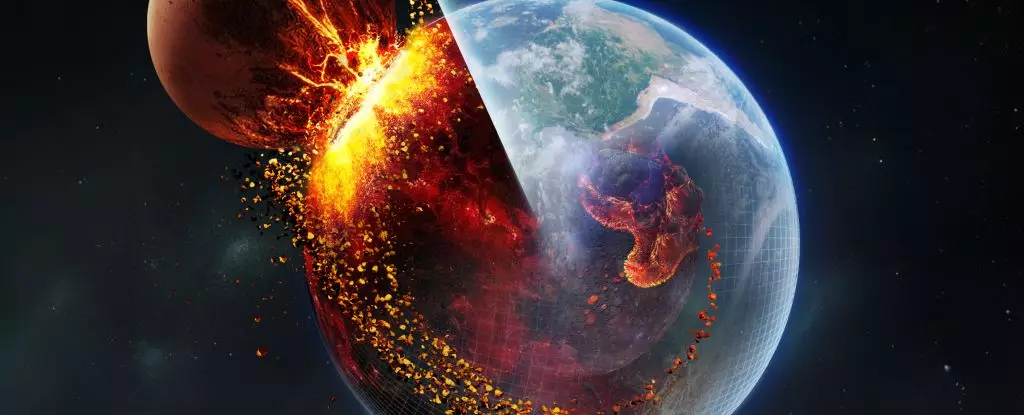Approximately 4.5 billion years ago, Earth experienced a colossal collision with a Mars-sized celestial body known as Theia. This impact was responsible for the formation of the Moon, but new evidence suggests that remnants of Theia are not only present in the Moon but also within Earth itself. This discovery challenges the conventional view of how the giant impact shaped Earth’s geological evolution and sheds light on the enigmatic presence of large low-shear-velocity provinces (LLVPs) deep beneath Earth’s mantle.
The Mysterious Large Low-Shear-Velocity Provinces (LLVPs)
LLVPs refer to dense, continent-sized regions that encircle Earth’s core-mantle boundary and have long puzzled scientists. These regions were initially attributed to internal Earth processes, including remnants of tectonic slabs or high-temperature anomalies. However, a team of researchers from China, the US, and the UK proposes an alternative explanation – Theia’s contribution to the formation of LLVPs.
Previous simulations suggested that Theia was mostly incorporated into the Moon, with trace amounts remaining in Earth. However, recent computer simulations conducted by the research team present compelling evidence that a significant portion of Theia’s material may have become embedded within Earth. This possibility opens up a new perspective on Earth’s composition and geological history.
Stratification of Earth’s Mantle
The team’s simulations demonstrate that Theia’s material mixed with Earth’s upper mantle in a liquid magma ocean, while the lower mantle remained relatively solid, predominantly comprising Earth’s own silicate material. Based on seismic data, this stratification may have endured throughout Earth’s history, influencing its current structure.
The Formation of LLVPs
The researchers’ simulations reveal that fragments of Theian material, ranging in size from tens of kilometers across, could have settled at the core-mantle boundary. Over time, these fragments accumulated and evolved into the LLVPs. Astonishingly, the study estimates that around 2 to 3 percent of Earth’s total mass could originate from Theia. Furthermore, the LLVP material is expected to be denser and richer in iron compared to Earth’s mantle.
The Quest for Confirmation
One exciting aspect of this discovery is the potential to verify its validity through future lunar missions. By comparing lunar mantle rocks with samples obtained from the mantle blobs associated with LLVPs, scientists could identify potential chemical signatures that align the two. This verification process can provide a deeper understanding of Earth’s history, its formation, and even shed light on the development of other planets and habitability within the wider galaxy.
If the giant impact hypothesis holds true, it would revolutionize our understanding of Earth and its unique characteristics. Earth, with its peculiar geological composition, might owe its existence to this cataclysmic event. By unraveling the mysteries of Earth’s past, we gain valuable insights into the formation of the Solar System and the potential habitability of exoplanets within the Milky Way.
The recent discovery of evidence supporting the presence of Theian material within Earth challenges the traditional notion of Earth’s homogenization due to the giant impact. Instead, it signals that this impact likely played a crucial role in the heterogeneity of Earth’s mantle. The investigation of LLVPs and their potential connection to Theia presents a new frontier for scientific inquiry, enabling us to revisit Earth’s past and unravel new mysteries about our planet’s history and the formation of the Solar System.


Leave a Reply